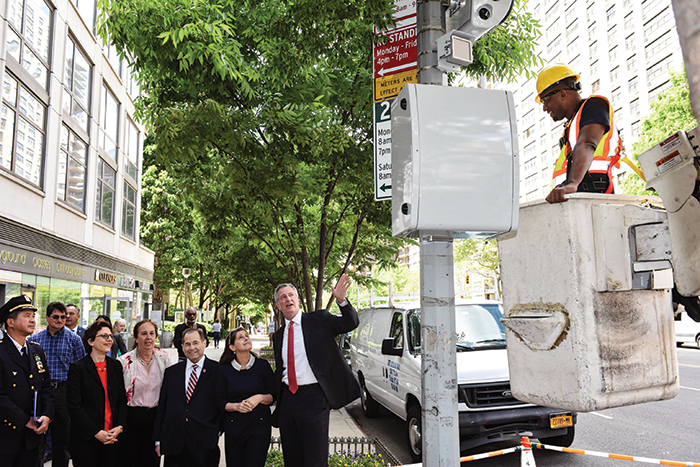Photo Courtesy of Michael Appleton/Mayoral Photography Office
“Speed cameras are an essential tool to fight back against dangerous driving, and State law should not force New York City to keep our city safe only some of the time,” Mayor de Blasio said.
By Forum Staff
Mayor Bill de Blasio on Friday highlighted findings from a landmark Department of Transportation report on the City’s speed camera program as he urged State leaders to allow New York City to operate the cameras 24 hours a day.
The DOT’s annual Automated Speed Enforcement Program report, which covers data from the speed camera program’s inception in 2014 through December 2020, highlights its continued success at curbing speeding by over 70 percent. However, analysis of 2020 fatalities showed that nearly 30 percent of all fatalities occur in speed camera zones during the hours they are not allowed to operate: overnight and on weekends.
In 2019, NYC DOT received State authorization to expand its speed camera program and operate cameras in 750 school speed zones, on all weekdays between 6 a.m. and 10 p.m., and at any location within a quarter-mile radius of the school building. As outlined in this year’s report, speeding at fixed camera locations had dropped, on average, 72 percent as of December 2020. The program currently has 1,647 cameras in all 750 school speed zones. DOT will install an average of 60 new cameras per month, with the aim of reaching a total of 2,220 cameras in 2022.
Excessive speed is one of the leading factors in serious crashes in New York City. The faster a vehicle is traveling, the more time and space a driver needs to react to circumstances to prevent a crash. Speeding also worsens the damage caused upon impact when a collision happens – a pedestrian who is struck by a vehicle traveling at 30 MPH is twice as likely to be killed as a pedestrian struck by a vehicle traveling at 25 MPH.
Highlights from this year’s report include:
- A total of 4,397,375 Notice of Liabilities (NOLs) issued in 2020
- Average weekly violations in newly installed school speed zones declined by about 45% from a camera’s first week to its 18th week
- Average daily speed violations declined between 81 percent and 89 percent in school speed zones along key corridors like Grand Concourse, Union Turnpike, Hylan Boulevard, and Fourth Avenue (Brooklyn).
Since the speed camera program began, just under half of vehicles receiving a NOL have not received a second. In 2020, 52 percent of vehicles received only one violation, even as the number of cameras increased due to the program’s expansion.
“Speed cameras are an essential tool to fight back against dangerous driving, and State law should not force New York City to keep our city safe only some of the time,” de Blasio said. “We’re proud to have one of the biggest speed camera programs in the world, and it’s time for Albany to let us operate them 24 hours a day. Anything less is unfair to everyone else who uses our streets.”
“While 2020 brought its own set of challenges with COVID-19, it also brought a second epidemic of reckless driving,” DOT Commissioner Hank Gutman added. “We know our speed camera program works to deter speeding, but we can do more.”

